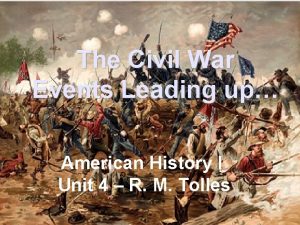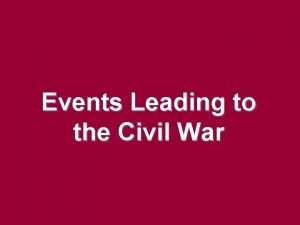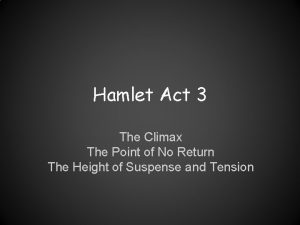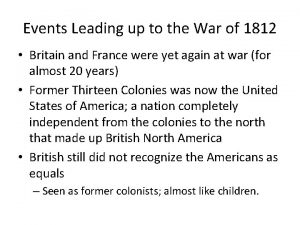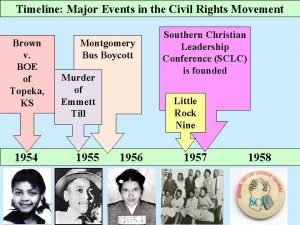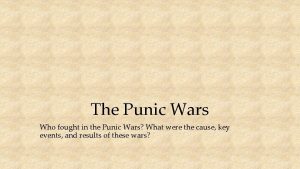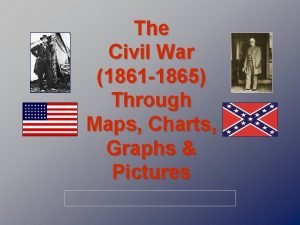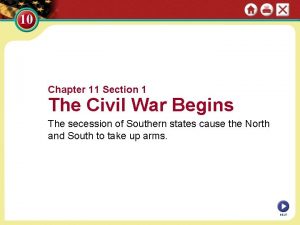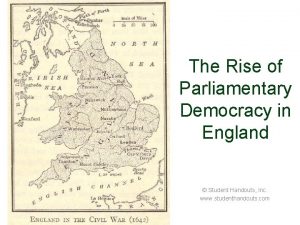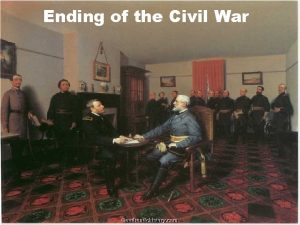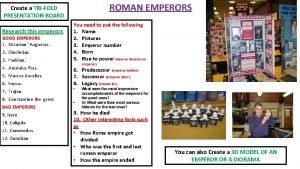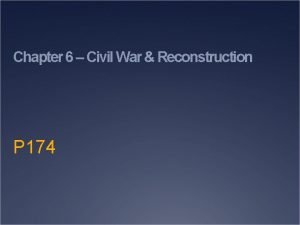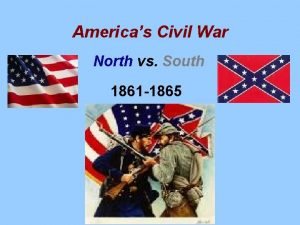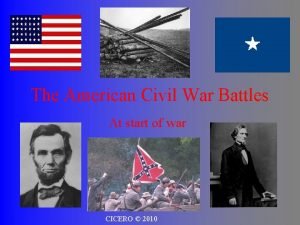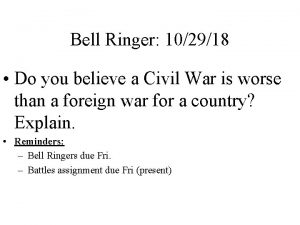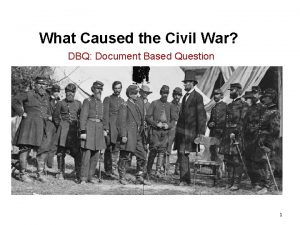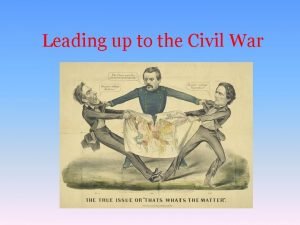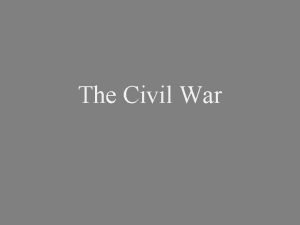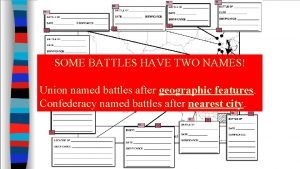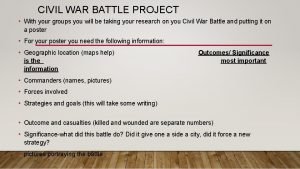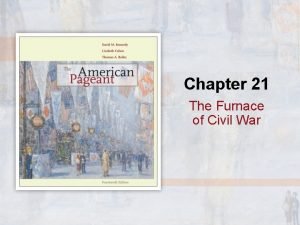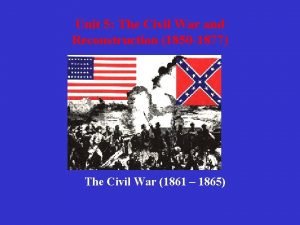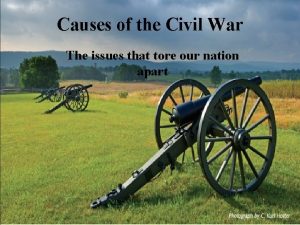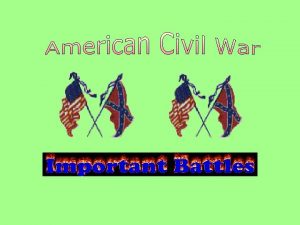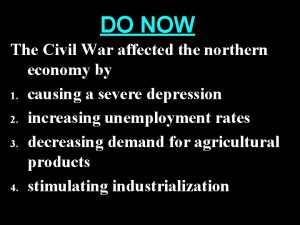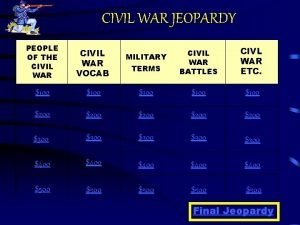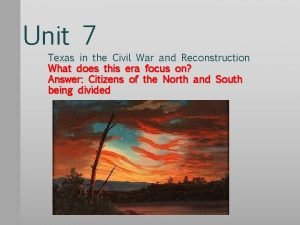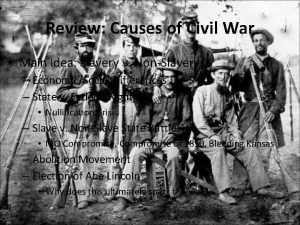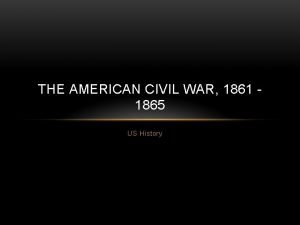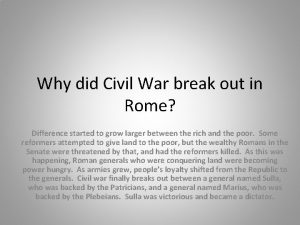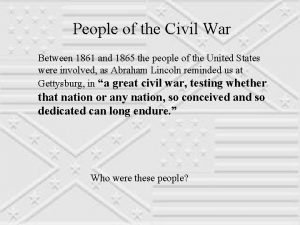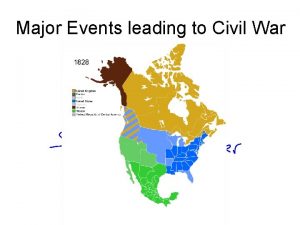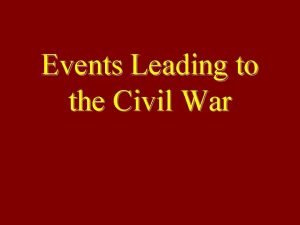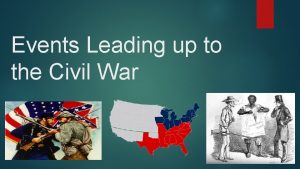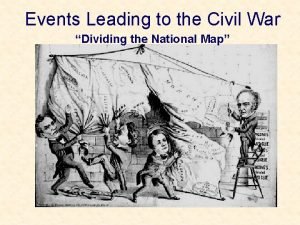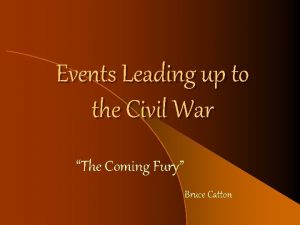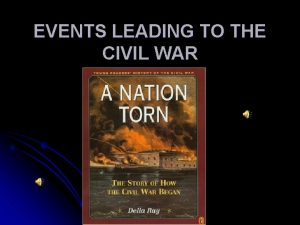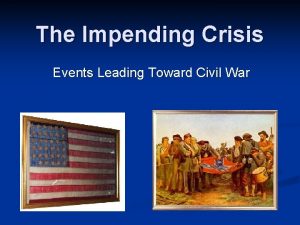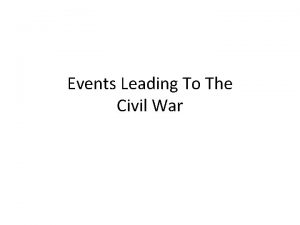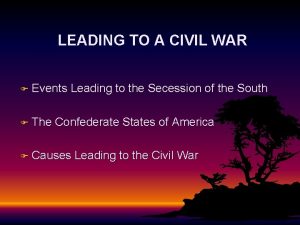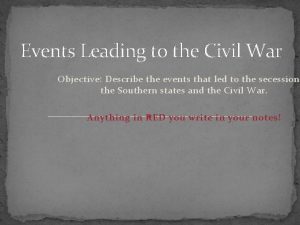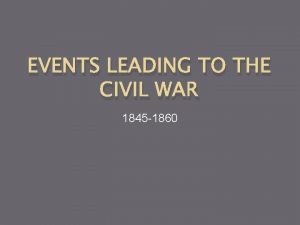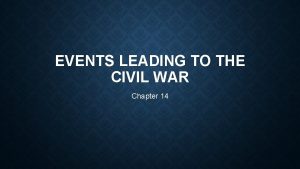Civil War Events Leading to the Civil War















































- Slides: 47

Civil War Events Leading to the Civil War GRAPHIC ORGANIZER ACTIVITY

Causes of the Civil War 1861 -1865

Sectionalism

Sectionalism • Loyalty to a part of the country as opposed to the whole country • North and South believed their way of life to be better

S lavery

S lavery • Involuntary servitude (forcing to work) • North wanted to abolish slavery • South needed to keep slavery to maintain their way of life

S tates’ Rights 10 th Amendment The powers not delegated to the United States by the Constitution, nor prohibited by it to the States, are reserved to the States respectively, or to the people.

S tates’ Rights • The belief that a state has the right not to follow a federal law if they are opposed to it

S ecession

S ecession • To break away from (in this case, the Union) • South Carolina first state to secede in 1860 • Resulted from the election of Abraham Lincoln

1 Constitution

1 Constitution • Founding Fathers compromised on the issue of slavery with the 3/5 ths Compromise and the importation of slaves ending in 1808 • They thought that slavery would be unprofitable and die out • The North will eventually end slavery within their borders, but the South will continue to practice slavery

2 Rise of the Abolitionist Movement

2 Rise of the Abolitionist Movement • People who wanted to end slavery in the U. S. completely • Both blacks and whites made speeches, created pamphlets, and made newspapers urging the ending of slavery • North successful in ending slavery by 1804

3 Underground Railroad

3 Underground Railroad • A series of secret routes and buildings where slaves hid while escaping North to gain freedom • They primarily traveled at night using trains, wagons, boats, and on foot • Many slaves destinations were Canada and Mexico because slavery was already outlawed in those areas

4 Missouri Compromise

4 Missouri Compromise • Henry Clay proposed • Maine is admitted as a free state, while Missouri is admitted as a slave state to maintain the balance of free vs. slave states in Congress • It drew an imaginary line at the southern border of Missouri at 36˚ 30’N line; slavery was permitted in the part of the Louisiana Purchase south of the line

5 Free Soil Party

5 Free Soil Party • A new political party was formed by antislavery members from both the Democrats and Whig parties • Free Soilers’ goal was to keep slavery out of the western territories

6 Compromise of 1850

6 Compromise of • Henry Clay proposed 1850 • Allowed California to enter the Union as a free state • Divided the rest of the Mexican Cession into the territories of New Mexico and Utah • Ended the slave trade in Washington, D. C. • Included a strict fugitive slave law • Settled a border dispute between Texas and New Mexico

7 Fugitive Slave Law

7 Fugitive Slave Law • Required all citizens to help catch runaway slaves and send back to owners • People who let fugitives escape could be fined $1000 and jailed for six months

8 Uncle Tom’s Cabin

8 Uncle Tom’s Cabin • Novel by Harriet Beecher Stowe which showed the evils of slavery and the injustice of the Fugitive Slave Law • Becomes a best seller and forces people to see slavery as a moral issue

9 Kansas-Nebraska Act

9 Kansas-Nebraska Act • Bill introduced by Stephen Douglas to set up a government for the Nebraska territory • Douglas wanted to build a transcontinental railroad system to help develop Chicago • Proposed that the Nebraska territory would be divided into two territories – Kansas and Nebraska • Voters in each territory would decide the issue of slavery by popular sovereignty • Repealed the Missouri Compromise

10 Violence in Congress

10 Violence in Congress • Senator Charles Sumner blasted the actions of proslavery legislature in Kansas and criticized Senator Andrew Butler from South Carolina • Butler’s nephew, Congressman Preston Brooks beat Sumner with a cane, proving that slavery led to violence

11 “Bleeding Kansas”

11 “Bleeding Kansas” • By late 1856, more than 200 people (proslavery and antislavery) had been killed in Kansas territory • All of this fighting was in response to whether or not Kanas should be a free or slave state

12 Dred Scott v. Sandford

12 Dred Scott v. Sandford • Dred Scott, a slave who sued for his freedom • Chief Justice Roger Taney of the Supreme Court ruled that Scott could not file a lawsuit because, as an enslaved person, he was not a citizen. Instead, all slaves were property • In addition, Congress did not have the power to outlaw slavery in the territories • Missouri Compromise is considered unconstitutional

13 Creation of Republican Party

13 Creation of Republican Party • Formed by Free Soilers, northern Democrats and antislavery Whigs • Goal was to keep slavery out of the western territories

14 Lincoln-Douglas Debates

14 Lincoln-Douglas Debates • Both Abraham Lincoln and Stephen Douglas were running for Senator of Illinois • Lincoln wanted to stop the spread of slavery • Douglas believed that the territories should be decided by popular sovereignty • Lincoln’s “house-divided” speech – “A house divided against itself cannot stand; a nation cannot endure half slave and half free. ” • Douglas won the re-election

15 John Brown’s Raid

15 John Brown’s Raid • Brown was an abolitionist who wanted to start a slave revolt • Brown and 18 men raided Harper’s Ferry arsenal to steal weapons and give them to the slaves to kill owners • Brown was captured and sentenced to death. He was hailed as a hero by the North, but hailed as a villain by the South.

16 Election of 1860

16 Election of 1860 • Abraham Lincoln – Republican • Stephen Douglas – Northern Democrat • John Breckinridge – Southern Democrat • John Bell – Constitutional Party • Lincoln wins the election

17 Secession

17 Secession • Because Lincoln won the election, many southern states decided to secede (leave the Union) • Southern states used states’ rights to justify secession • The states that seceded formed a new nation and called it the Confederate States of America

18 Firing at Fort Sumter, South Carolina

18 Firing at Fort Sumter, South Carolina • Confederacy began seizing federal forts and arsenals • Lincoln refused to abandon Fort Sumter and the Confederates wanted it because it guarded the Charleston Harbor • The fort needed to be resupplied and the Union refused to surrender it to the Confederates • Confederate soldiers opened fire and it marked the beginning of the war • Union surrendered the fort

© 2015 A Social Studies Life *Purchasing this product entitles you to one non-transferable single-user license. You may use this product for personal use. However, by purchasing, you agree to the following terms: • Any product that you distribute must provide credit back to A Social Studies Life. • You may not alter, resell, share, or distribute this product without the proper purchase of license(s). • You may not use the graphics within the product to create any materials for others to resell. Some graphics have been purchased for creation by other Tp. T sellers and they have been given credit. • This product is intended for personal use only. If you intend to copy and distribute this product to others, extra license(s) must be purchased. • Purchasing does not mean you own the product and you may not claim it as your own. Lauren Webb –A Social Studies Life retains the copyright of the product. • Copying any part of this product and placing it on the internet in any form (even a personal or classroom website) is strictly forbidden and is in violation of the Digital Millennium Copyright Act (DMCA). These items can be picked up in a Google search & then shared worldwide for free. These terms are subject to change without notice. Please contact me if you have any questions about proper use or further licensing options. Due to the digital nature of this product, no returns or refunds are available. Thank you for respecting my work!
 Image
Image Bobbin leading principle
Bobbin leading principle What events led to the civil war
What events led to the civil war Climax de hamlet
Climax de hamlet Hamlet act 3 events leading to climax
Hamlet act 3 events leading to climax Why was the civil war the first modern war
Why was the civil war the first modern war Toward civil war lesson 3 secession and war
Toward civil war lesson 3 secession and war Mutually exclusive vs non mutually exclusive
Mutually exclusive vs non mutually exclusive Leading up to the war of 1812
Leading up to the war of 1812 Civil rights timeline of events
Civil rights timeline of events Civil rights and civil liberties webquest
Civil rights and civil liberties webquest Who fought the punic wars
Who fought the punic wars The civil war
The civil war Civil war readers theater
Civil war readers theater American civil war battles map
American civil war battles map Causes of the english civil war
Causes of the english civil war The civil war begins chapter 11 section 1
The civil war begins chapter 11 section 1 Civil war dates
Civil war dates Civil war map sherman's march to the sea
Civil war map sherman's march to the sea Causes of the civil war jeopardy
Causes of the civil war jeopardy Civil war
Civil war Trifold presentation
Trifold presentation Chapter 6 civil war and reconstruction
Chapter 6 civil war and reconstruction North and south states civil war
North and south states civil war Who wonthe battle of shiloh
Who wonthe battle of shiloh Civil war bell ringers
Civil war bell ringers Lincoln interpreted his reelection as a mandate to
Lincoln interpreted his reelection as a mandate to Causes of the civil war dbq
Causes of the civil war dbq Chinese civil war resumes
Chinese civil war resumes North vs south civil war
North vs south civil war What led to the civil war
What led to the civil war Diseases in civil war
Diseases in civil war What led to civil war
What led to civil war Why do civil war battles have two names
Why do civil war battles have two names Civil war battle project
Civil war battle project Chapter 21 the furnace of civil war
Chapter 21 the furnace of civil war Unit 5 civil war and reconstruction
Unit 5 civil war and reconstruction What were the 4 main causes of the civil war
What were the 4 main causes of the civil war Mississippi civil war sites map
Mississippi civil war sites map The civil war affected the northern economy by
The civil war affected the northern economy by Jeopardy civil war questions
Jeopardy civil war questions Relative chronology
Relative chronology Conclusion of the civil war
Conclusion of the civil war America civil war
America civil war Why did civil war break out in rome
Why did civil war break out in rome Civil war 1861/1862
Civil war 1861/1862 The turning point of the civil war
The turning point of the civil war North and south states civil war
North and south states civil war
